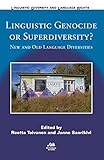Linguistic Genocide or Superdiversity? : New and Old Language Diversities / ed. by Reetta Toivanen, Janne Saarikivi.
Material type: TextSeries: Linguistic Diversity and Language RightsPublisher: Bristol ; Blue Ridge Summit : Multilingual Matters, [2016]Copyright date: ©2016Description: 1 online resourceContent type:
TextSeries: Linguistic Diversity and Language RightsPublisher: Bristol ; Blue Ridge Summit : Multilingual Matters, [2016]Copyright date: ©2016Description: 1 online resourceContent type: - 9781783096053
- 9781783096060
- Code switching (Linguistics)
- Code switching (Linguistics)
- Endangered languages
- Historical linguistics
- Language and languages -- Variation
- LANGUAGE ARTS & DISCIPLINES / Linguistics / General
- Language change
- Language death
- Language endangerment
- Language extinction
- Language revitalisation
- Language variation
- Minorities
- Plurilingualism
- Sociolinguistics
- Superdiversity
- 417.7
- P120.V37 L514 2016
- P120.V37
- online - DeGruyter
- Issued also in print.
| Item type | Current library | Call number | URL | Status | Notes | Barcode | |
|---|---|---|---|---|---|---|---|
 eBook
eBook
|
Biblioteca "Angelicum" Pont. Univ. S.Tommaso d'Aquino Nuvola online | online - DeGruyter (Browse shelf(Opens below)) | Online access | Not for loan (Accesso limitato) | Accesso per gli utenti autorizzati / Access for authorized users | (dgr)9781783096060 |
Frontmatter -- Contents -- Contributors -- Introduction to New and Old Language Diversities: Language Variation and Endangerment in Changing Minority Communities -- Part 1: Language Communities or Networks of Communication? Old and New Linguistic Diversity -- 1. Fragmentation of the Karelian Language and Its Community: Growing Variation at the Threshold of Language Shift -- 2.What's Up Helsinki?: Linguistic Diversity Among Suburban Adolescents -- 3. Varieties of Erzya-Russian Code-Switching in Radio Vaygel Broadcasts -- 4. Udmurt on Social Network Sites: A Comparison with the Welsh Case -- Part 2: Standardising Languages and Ethnicities: Mission Impossible? -- 5. A Tale of a City and Its Two Languages: A History of Bilingual Practices in the City of Bilbao -- 6. Nationalising Fluid and Ambiguous Identities: Russia, Western Ukraine and Their Ukrainian and Russian Minorities, Diasporas and 'Compatriots Abroad' -- 7. Emergent Sámi Identities: From Assimilation Towards Revitalisation -- 8. Localising the Global in the Superdiverse Municipalities of the Arctic: The Case of Inari -- Part 3: Language Revitalisation: Protection Standards or Tolerance for Variation -- 9. Russia's Minority Education and the European Language Charter -- 10. Metadiversity, or the Uniqueness of the Lambs -- 11. Division of Responsibility in Karelian and Veps Language Revitalisation Discourse -- 12. Standard Language Ideology and Minority Languages: The Case of the Permian Languages -- Index
restricted access online access with authorization star
http://purl.org/coar/access_right/c_16ec
Are we facing an immense wave of language death or a period of remarkable new linguistic variation? Or both? This book answers this question by analysing studies of language endangerment and loss along with those of language change, revitalization and diversity. Using case studies from Russia and the EU, the authors compare historical language variation to that of the present day, arguing that accelerated language extinction can be considered a result of colonization, modernization and globalization, but so too can many new creoles, intertwined and mixed languages, new ethnic identities, new groups of urban dwellers or migrant groups, all with their own distinct cultural traits. The book therefore surmises that the linguistic heritage of today is simultaneously more endangered and more diverse than ever before.
Issued also in print.
Mode of access: Internet via World Wide Web.
In English.
Description based on online resource; title from PDF title page (publisher's Web site, viewed 24. Apr 2022)


